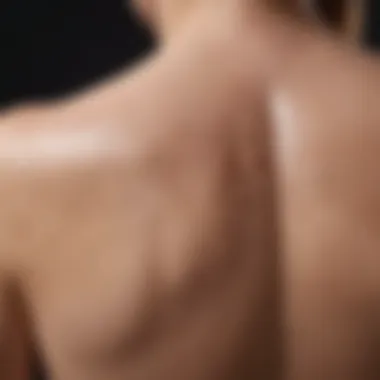Effective Strategies for Treating Back Acne


Intro
Back acne, often termed as bacne, is a condition that affects numerous individuals but tends to receive minimal attention compared to facial acne. Unlike facial acne, the skin on our back can have distinct challenges due to its thickness and the presence of larger glands. This article addresses the various strategies necessary for dealing with back acne, providing insights into its causes, preventive measures, effective treatments, and lifestyle adjustments.
Understanding back acne requires comprehensive knowledge of potential triggers, from hormonal fluctuations to certain fabrics that can irritate the skin. Moreover, managing this condition often involves a multifaceted approach—combining skincare routines, dietary considerations, and even professional treatments. This exploration aims to equip readers with the information to tackle back acne confidently and effectively, leading to healthier skin overall.
Understanding Back Acne
Understanding back acne is crucial for effective treatment and management. This skin condition can significantly affect one’s self-esteem and overall well-being. The skin on the back is often more prone to acne due to factors like oiliness, sweat, and the type of clothing people wear. Recognizing the underlying reasons for back acne can help tailor a more effective approach to treatment.
Definition and Overview
Back acne, also known as bacne, refers to acne that appears on the back and can manifest as pimples, cysts, or nodules. Like facial acne, it occurs when hair follicles become clogged with oil and dead skin cells. Back acne can appear at any age but is most common during puberty due to hormonal fluctuations. It is important to differentiate back acne from other skin conditions like folliculitis or psoriasis, which require different treatment strategies.
Common Triggers
Identifying triggers for back acne is essential for prevention. Several factors can contribute to its development, including:
- Hormonal changes: Fluctuations during puberty, menstruation, or hormonal treatments can increase oil production.
- Excessive sweating: Physical activity and hot weather can lead to clogged pores.
- Certain clothing: Tight clothing or materials that trap sweat can irritate the skin.
- Diet: High sugar and dairy intake may exacerbate acne.
- Stress: Increased stress can lead to hormonal changes, worsening acne.
Understanding these triggers allows individuals to make informed choices about their lifestyles and skincare practices.
Skin Type Considerations
Everyone's skin type reacts differently to products and environmental factors. Factors to consider include:
- Oily skin: Individuals with oily skin may produce excess sebum, increasing acne risk.
- Dry skin: Dry skin can still be prone to acne when pores become clogged by dryness and dead skin.
- Sensitive skin: Certain treatments may cause irritation, so gentler approaches might be necessary.
- Combination skin: This type requires a tailored approach, as different areas of the back may respond differently to products.
Tailoring treatments based on these skin type considerations increases the chances of effective management of back acne.
Preventive Measures
Preventive measures play a crucial role in managing and reducing back acne. Focusing on these strategies can help individuals maintain clearer skin and diminish the likelihood of flare-ups. Preventing back acne involves a combination of lifestyle choices, hygiene practices, and appropriate skin care routines. Recognizing the importance of these elements can significantly improve one’s overall skin health.
Hygiene Practices
Maintaining proper hygiene is fundamental in preventing back acne. Regular washing of the skin helps remove excess oils, sweat, and bacteria that may contribute to breakouts. It is advisable to shower after exercising or engaging in activities that induce sweating. Use a gentle, non-comedogenic body wash, which means it won’t block pores. These body washes often include ingredients like salicylic acid or tea tree oil, known for their acne-fighting properties.
Tip: Gently exfoliating the back two to three times a week can help remove dead skin cells. This prevents clogged pores, making it a simple yet effective practice.
Clothing Selection
Clothing choices can significantly affect back acne. Wearing loose-fitting clothes made from breathable fabrics like cotton can help reduce sweat build-up on the skin. Tight or non-breathable materials often trap moisture and create an environment conducive to the growth of bacteria. Pay attention to workout clothes, as these tend to cling to the skin and absorb sweat more than regular clothing. Opt for moisture-wicking fabrics that are specifically designed for athletic wear. Avoiding heavy backpacks that directly contact the back can also be beneficial.
Skin Care Regimen
A tailored skin care regimen is imperative for managing back acne effectively. Using body lotions or creams that are oil-free and non-comedogenic can help keep the skin moisturized without promoting breakouts. Incorporating topical treatments with active ingredients like benzoyl peroxide or retinoids into the routine may also yield positive results. It is essential to apply these products as directed, and to test on a small skin area first to ensure there is no adverse reaction.
Routine is key. Establish a consistent time for applying skin treatments and cleansing. The synergy between good hygiene, proper clothing, and mindful skin care can create an environment less favorable for back acne, thus effectively reducing its occurrence.
Topical Treatments
Topical treatments play a crucial role in addressing back acne. These treatments are applied directly to the skin and target specific areas of concern. Their significance lies in their ability to deliver medication directly to the affected skin, allowing for more concentrated and effective results. Understanding the various types of topical treatments available can empower individuals as they navigate their skincare journey.
Benzoyl Peroxide
Benzoyl peroxide is widely recognized for its efficacy against acne. This compound works by reducing the presence of acne-causing bacteria on the skin. It also helps to unclog pores and promote skin shedding, which is key in preventing acne formation. When using products containing benzoyl peroxide, it's essential to start with a lower concentration, such as 2.5%, to assess skin tolerance.
Benefits of Benzoyl Peroxide include:
- Reduces bacteria levels
- Helps unclog pores
- Minimizes inflammation


However, it's important to be mindful regarding potential side effects. Benzoyl peroxide can cause dryness and peeling. Thus, incorporating a good moisturizer is advisable when using it as part of your regimen.
Salicylic Acid
Salicylic acid is another powerful treatment for back acne. This beta hydroxy acid penetrates deep into the pores, effectively exfoliating the skin and dissolving debris. It is particularly beneficial for those with oily skin, as it helps to reduce excess sebum production.
Key advantages of salicylic acid are:
- Deep pore cleaning
- Anti-inflammatory properties
- Great for oily skin types
Regular application can yield significant improvements in skin texture and clarity. It is typically available in various forms, including cleansers, gels, and spot treatments. Monitoring how the skin reacts to salicylic acid is essential, as some may experience irritation if used too frequently.
Retinoids
Retinoids are a class of compounds derived from vitamin A and are potent tools for combating acne. They work by speeding up cell turnover, preventing clogged pores, and reducing the appearance of existing blemishes. Retinoids are available in both over-the-counter and prescription formulations.
Benefits of retinoids include:
- Accelerated skin cell turnover
- Diminished pore size
- Reduced appearance of acne scars
While they are effective, retinoids can cause initial redness and peeling. It is advisable to start with a lower concentration at night, gradually increasing use as the skin adapts.
Natural Alternatives
For those looking for milder options, natural alternatives can be effective in treating back acne. Ingredients such as tea tree oil, witch hazel, and aloe vera have shown potential in reducing inflammation and promoting healing. These alternatives are typically gentler on the skin compared to conventional treatments.
Natural alternatives may offer:
- Fewer side effects
- A holistic approach to skin health
- Beneficial properties from botanical sources
However, it is crucial to conduct a patch test before applying these substances widely on the back to rule out any adverse reactions. Each individual may respond differently to natural treatments, making it vital to approach them with caution.
Topical treatments can significantly improve back acne, but consistency and careful product selection are key to achieving desired results.
In summary, topical treatments represent a significant aspect of managing back acne. Benzoyl peroxide, salicylic acid, retinoids, and natural alternatives each have unique benefits and can be tailored to suit different skin types and concerns. Understanding how to use these treatments effectively can encourage more confident and clear skin.
Oral Treatments
Oral treatments play a vital role in managing back acne, particularly for cases that are moderate to severe. This aspect of treatment is crucial when topical solutions alone do not yield satisfactory results. By addressing back acne from an internal perspective, oral therapies can effectively reduce inflammation, control bacteria, and regulate hormones that may contribute to breakouts. As we explore this section, we will discuss various oral treatment options, their mechanisms, advantages, and important considerations when integrating them into a skin care regimen.
Antibiotics
Antibiotics are commonly prescribed for back acne treatment, especially in cases where the acne is inflamed or caused by bacterial infection. Medications like minocycline and doxycycline are often effective. They work by reducing the number of bacteria present on the skin and decreasing inflammation. It is essential to take these medications as directed by a healthcare professional, as misuse can lead to antibiotic resistance.
Benefits of antibiotics include:
- Quick reduction in pustules: Many patients notice improvement within weeks.
- Lower risk of scarring: Reducing inflammation can minimize post-acne marks.
However, potential side effects such as stomach upset and increased sun sensitivity should not be ignored. Patients must discuss their full medical history with their doctors, considering any pre-existing conditions that might affect treatment outcomes.
Hormonal Therapy
For individuals whose back acne is significantly influenced by hormonal fluctuations, hormonal therapy can be an effective treatment. This is often more relevant to women, especially those who experience breakouts around their menstrual cycle or have conditions like polycystic ovary syndrome (PCOS).
Hormonal treatments may include birth control pills or anti-androgens such as spironolactone. These medications work by regulating hormones that can trigger acne production. They help to balance levels of androgens, which are male hormones that can increase sebum production.
Key considerations for hormonal therapy include:
- Need for a prescription: Proper medical supervision is crucial because of potential side effects.
- Time to take effect: Patients may need to be patient, as it can take several months to see benefits.


Oral Retinoids
Oral retinoids, particularly isotretinoin, are among the most powerful treatments for severe back acne. By reducing oil production in the skin, these medications help prevent clogged pores, thereby minimizing breakouts. Isotretinoin is also effective in reducing inflammation and the overall severity of acne.
This treatment is often reserved for the most stubborn cases due to its potent effects and potential side effects, which may include:
- Dry skin and lips: Users need to hydrate adequately to combat these effects.
- Potential for serious birth defects: Hence, strict guidelines exist for women of childbearing age.
Regular check-ups with a dermatologist are recommended for anyone undergoing oral retinoid therapy. Monitoring liver function and lipid levels can help mitigate the risk of complications.
The key to effective treatment of back acne often lies in a tailored approach. A healthcare provider can help determine the best pathway.
In summary, oral treatments offer significant benefits for managing back acne, especially in moderate to severe cases. With a range of options, from antibiotics to hormonal therapy and oral retinoids, patients have tools available to combat this skin condition effectively. It is vital to have open discussions with healthcare providers to navigate these treatments safely and effectively.
Professional Interventions
Professional interventions play a vital role in treating back acne effectively, especially when standard over-the-counter treatments do not yield desired results. These interventions, administered by trained professionals, can target the deeper layers of the skin and help address severe cases or persistent issues. Consulting with experts in dermatology ensures that individuals receive personalized treatment plans tailored to their specific skin needs. The benefits of seeking professional intervention include access to advanced tools and techniques, better assessment of underlying causes, and guidance on long-term management to prevent outbreaks in the future.
Dermatological Consultations
A consultation with a dermatologist is often the first step in addressing back acne. Dermatologists can identify the type of acne and its potential causes, which may include hormonal imbalances or other underlying health issues. During the consultation, the dermatologist will typically perform a thorough skin examination and may ask about personal and family health history.
This detailed evaluation helps formulate an effective treatment plan which might include topical or oral medications. Moreover, dermatologists can assess if there are any lifestyle factors contributing to the condition, such as diet or skincare products used.
It is crucial to follow up after initial treatments to monitor progress. Regular check-ins allow the dermatologist to make adjustments if necessary.
Chemical Peels
Chemical peels are a common professional intervention for treating back acne. They work by applying a chemical solution that exfoliates the top layer of skin, promoting new skin growth. This process not only helps in clearing existing acne but also minimizes the appearance of acne scars. Most chemical peels involve substances like glycolic acid or salicylic acid, which are known for their exfoliating properties.
The benefits of chemical peels include:
- Reduced acne lesions
- Improved skin texture
- Diminished post-acne marks
However, patients must take care to consult with a qualified dermatologist first. The treatment is not suitable for everyone, especially for those with sensitive skin. Proper aftercare is also vital to ensure optimal recovery and results.
Light Therapies
Light therapies have gained popularity as a professional intervention for back acne. These therapies utilize specific wavelengths of light to target the bacteria that contribute to acne. Blue light therapy is particularly effective as it directly kills the bacteria responsible for inflamed lesions. On the other hand, red light therapy can help reduce inflammation and promote healing.
Treatment with light therapy typically follows a series of sessions, each lasting approximately 20 to 30 minutes.
"Professional treatments like light therapies provide a focused approach to skin concerns, often producing quicker results than home remedies."
Like other treatments, light therapy should be undertaken with professionalism and may not be suitable for all skin types. It is essential to discuss all options with a dermatologist to ensure it aligns with personal skin goals and health conditions.
In summary, professional interventions can provide an effective route for individuals struggling with back acne. From thorough dermatological consultation to advanced treatments like chemical peels and light therapies, these methods offer solutions that are often beyond the reach of over-the-counter products. Taking a proactive approach by seeking professional help can lead to better long-term skin health.
Lifestyle Adjustments
Making thoughtful lifestyle adjustments is crucial in managing back acne effectively. These modifications can complement medical treatments and topical solutions, creating a holistic approach to skin health. Understanding how everyday choices impact skin conditions is vital.
Dietary Considerations
Diet plays an indirect role in the health of your skin. Certain foods may trigger acne, while others might promote clear skin. For example, a high-glycemic index (GI) diet, which includes sugary and processed foods, has been linked to increased acne formation. Instead, focus on incorporating whole foods rich in antioxidants, vitamins, and minerals. Foods like fruits and vegetables, particularly leafy greens, can enhance skin health. Omega-3 fatty acids found in fish such as salmon or in walnuts may also reduce inflammation. Be mindful of dairy consumption as some studies suggest a potential link between dairy products and acne.
- Opt for Low-GI Foods: Choose whole grains, legumes, and healthy fats.
- Include Antioxidant-Rich Produce: Blueberries and spinach can help combat oxidative stress.
- Consider Omega-3 Sources: Fatty fish and flaxseeds may aid in managing inflammation.
Hydration Importance


Staying properly hydrated is essential for overall skin health. Water aids in detoxifying the body and can play a role in keeping skin moisturized. When skin lacks hydration, it may produce more oil, potentially worsening acne. Aim for at least eight glasses of water daily, adjusting based on your activity level and climate. Herbal teas can also serve as great alternatives, but avoid sugary beverages. Regular consumption of water can lead to improved skin texture and reduced breakouts.
- Aim for Hydration: Eight glasses of water as a baseline.
- Incorporate Herbal Teas: These can add variety while supporting hydration.
Exercise and Sweat Management
Regular exercise has numerous benefits, including improved circulation and stress reduction. When you exercise, your body releases sweat, which can help clear out pores. However, it is crucial to manage sweat effectively post-workout. Skin that is damp with sweat may become a breeding ground for bacteria if not addressed. Opt for breathable fabrics during workouts and take a shower afterward to cleanse the sweat and bacteria from your back. Additionally, ensure that gym equipment is cleaned to avoid contact with potential irritants.
- Engage in Regular Physical Activity: Aim for at least 30 minutes daily.
- Shower After Exercise: Cleanse sweat to minimize bacterial growth.
- Choose Appropriate Clothing: Select moisture-wicking fabrics that allow the skin to breathe.
Making lifestyle adjustments is not just about treating back acne in the short term; it is about fostering enduring habits for healthier skin in the long run.
Long-Term Management
Long-term management of back acne is crucial. It helps in maintaining skin health and preventing future breakouts. Effective strategies can reduce the occurrence of acne while improving the overall appearance of the skin. This section discusses the importance of monitoring skin changes, establishing a consistent skincare routine, and recognizing when to seek professional help.
Monitoring Skin Changes
Regularly monitoring skin changes enables you to identify patterns and triggers specific to your back acne. This is particularly important since skin conditions can evolve. Noting any new lesions, persistent redness, or changes in the texture can inform your treatment approach. Keeping a daily journal can help track any changes, along with dietary habits and product usage.
Benefits of Monitoring:
- Early Identification: Spotting changes early can prevent exacerbation of breakouts.
- Informed Decision-Making: Knowing what works and what does not supports better choices regarding treatments.
- Customized Care: As your skin condition evolves, your approach may need adjustments.
Establishing a Routine
A structured skincare routine is essential for managing back acne. Consistency holds the key. An effective routine generally includes cleansing, exfoliating, and moisturizing. Radiant skin begins with thorough cleansing to remove dirt and oil. Follow up with a gentle exfoliation once or twice weekly to eliminate dead skin cells.
Sample Routine:
- Cleanse: Use a mild cleanser specifically formulated for acne-prone skin.
- Exfoliate: Incorporate a light exfoliant onto your routine.
- Moisturize: Apply a non-comedogenic lotion to keep skin hydrated without clogging pores.
- Treat: If necessary, apply topical treatments like benzoyl peroxide or salicylic acid.
When to Seek Help
Recognizing when to seek help from a dermatologist is vital for effective long-term management. If conventional treatments fail to provide improvement, it’s time to consult a specialist. Conditions worsened by hormonal factors or stress might need professional intervention, such as prescription medications or advanced treatments.
Signs You Should Consult a Dermatologist:
- Persistent Acne: Acne that does not respond to over-the-counter solutions.
- Severe Inflammation: Severe swelling or pain around blemishes.
- Dermatological Changes: Any unusual skin changes that cause concern.
Professional advice can lead you to effective treatments and a tailored care plan for your specific needs.
Maintaining skin health through long-term management practices is all about consistency and mindfulness about how skin responds to various factors. By staying informed and proactive, the chances of clear, healthy skin increase tremendously.
The End
In concluding the discussion on back acne, it is essential to recognize the complexity of this condition and the various multifaceted strategies available to treat it. Not merely a cosmetic issue, back acne can significantly affect one’s confidence and quality of life. Thus, understanding effective treatments becomes crucial.
Each section of this article has explored significant aspects including preventive measures, topical and oral treatments, professional interventions, and lifestyle adjustments. This comprehensive approach underscores the importance of addressing the root causes of back acne while also implementing effective treatment options. Through informed decisions, individuals can pursue clearer skin.
The overall benefits of properly managing back acne extend beyond aesthetic improvements. They contribute to mental well-being, encouraging a more positive self-image. Moreover, a consistent routine tailored to one’s skin type can result in lasting change and enhanced skin health.
It cannot be overstated that seeking professional advice is invaluable in this journey. Dermatologists can provide personalized recommendations that adapt to one’s specific skin condition and needs. In sum, proactive management of back acne not only addresses the physical aspects but also fosters a greater sense of empowerment.
Summary of Key Points
- Understanding Back Acne: Recognizing the condition, its triggers, and skin type considerations is critical in formulating an effective strategy.
- Preventive Measures: Good hygiene, appropriate clothing, and a suitable skin care routine can greatly reduce the occurrence of back acne.
- Topical Treatments: Options like benzoyl peroxide, salicylic acid, and retinoids can help in treating current breakouts and preventing future ones.
- Oral Treatments: In some cases, antibiotics or hormonal therapies may be necessary for comprehensive treatment.
- Professional Interventions: Consulting a dermatologist and exploring treatments such as chemical peels or light therapies can provide enhanced results.
- Lifestyle Adjustments: Diet, hydration, and exercise play a pivotal role in skin health and should not be overlooked.
- Long-Term Management: Continuous monitoring and adjustments to one’s regimen can lead to sustained results.
Final Thoughts
Adopting a strategic and informed approach to treating back acne is vital. It is important to remember that each individual’s skin is different, necessitating a tailored plan rather than a one-size-fits-all solution. Over time, commitment to a regimen encompassing prevention, treatment, and professional guidance yields positive results.
As a collective emphasis on skin health grows, so does the understanding of back acne among consumers. It is now more than ever essential for individuals to be equipped with knowledge and strategy, thereby allowing for healthier skin outcomes.
This journey towards clearer skin involves patience and persistence. However, the rewards extend far beyond physical appearance, enabling individuals to embrace their skin with confidence.







